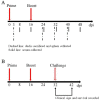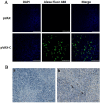Oral Vaccination with a DNA Vaccine Encoding Capsid Protein of Duck Tembusu Virus Induces Protection Immunity
- PMID: 29642401
- PMCID: PMC5923474
- DOI: 10.3390/v10040180
Oral Vaccination with a DNA Vaccine Encoding Capsid Protein of Duck Tembusu Virus Induces Protection Immunity
Abstract
The emergence of duck tembusu virus (DTMUV), a new member of the Flavivirus genus, has caused great economical loss in the poultry industry in China. Since the outbreak and spread of DTMUV is hard to control in a clinical setting, an efficient and low-cost oral delivery DNA vaccine SL7207 (pVAX1-C) based on the capsid protein of DTMUV was developed and evaluated in this study. The antigen capsid protein was expressed from the DNA vaccine SL7207 (pVAX1-C), both in vitro and in vivo. The humoral and cellular immune responses in vivo were observed after oral immunization with the SL7207 (pVAX1-C) DNA vaccine. High titers of the specific antibody against the capsid protein and the neutralizing antibody against the DTMUV virus were both detected after inoculation. The ducks were efficiently protected from lethal DTMUV exposure by the SL7207 (pVAX1-C) vaccine in this experiment. Taken together, we demonstrated that the capsid protein of DTMUV possesses a strong immunogenicity against the DTMUV infection. Moreover, an oral delivery of the DNA vaccine SL7207 (pVAX1-C) utilizing Salmonella SL7207 was an efficient way to protect the ducks against DTMUV infection and provides an economic and fast vaccine delivery strategy for a large scale clinical use.
Keywords: Flavivirus; capsid protein; duck tembusu virus; immunogenicity; oral DNA vaccine.
Conflict of interest statement
The author declare that they have no competing interests.
Figures




Similar articles
-
Oral Delivery of a DNA Vaccine Expressing the PrM and E Genes: A Promising Vaccine Strategy against Flavivirus in Ducks.Sci Rep. 2018 Aug 17;8(1):12360. doi: 10.1038/s41598-018-30258-3. Sci Rep. 2018. PMID: 30120326 Free PMC article.
-
Immunization with a suicidal DNA vaccine expressing the E glycoprotein protects ducklings against duck Tembusu virus.Virol J. 2018 Sep 14;15(1):140. doi: 10.1186/s12985-018-1053-0. Virol J. 2018. PMID: 30217161 Free PMC article.
-
A recombinant adenovirus expressing the E protein of duck Tembusu virus induces protective immunity in duck.J Vet Med Sci. 2019 Feb 28;81(2):314-320. doi: 10.1292/jvms.18-0036. Epub 2018 Dec 24. J Vet Med Sci. 2019. PMID: 30584200 Free PMC article.
-
Innate immune responses to duck Tembusu virus infection.Vet Res. 2020 Jul 8;51(1):87. doi: 10.1186/s13567-020-00814-9. Vet Res. 2020. PMID: 32641107 Free PMC article. Review.
-
Advancements in Research on Duck Tembusu Virus Infections.Viruses. 2024 May 20;16(5):811. doi: 10.3390/v16050811. Viruses. 2024. PMID: 38793692 Free PMC article. Review.
Cited by
-
Transcriptome analysis of duck embryo fibroblasts for the dynamic response to duck tembusu virus infection and dual regulation of apoptosis genes.Aging (Albany NY). 2020 Sep 7;12(17):17503-17527. doi: 10.18632/aging.103759. Epub 2020 Sep 7. Aging (Albany NY). 2020. PMID: 32897243 Free PMC article.
-
Structure and function of capsid protein in flavivirus infection and its applications in the development of vaccines and therapeutics.Vet Res. 2021 Jun 30;52(1):98. doi: 10.1186/s13567-021-00966-2. Vet Res. 2021. PMID: 34193256 Free PMC article. Review.
-
Recent Advances in Oral Vaccines for Animals.Vet Sci. 2024 Aug 5;11(8):353. doi: 10.3390/vetsci11080353. Vet Sci. 2024. PMID: 39195807 Free PMC article. Review.
-
Avian Flavivirus Enters BHK-21 Cells by a Low pH-Dependent Endosomal Pathway.Viruses. 2019 Nov 30;11(12):1112. doi: 10.3390/v11121112. Viruses. 2019. PMID: 31801284 Free PMC article.
-
Mucosal Vaccination: A Promising Alternative Against Flaviviruses.Front Cell Infect Microbiol. 2022 Jun 15;12:887729. doi: 10.3389/fcimb.2022.887729. eCollection 2022. Front Cell Infect Microbiol. 2022. PMID: 35782117 Free PMC article. Review.
References
-
- Thai K.T., Nga T.T., van Nam N., Phuong H.L., Giao P.T., Hung le Q., Binh T.Q., van Doornum G.J., de Vries P.J. Incidence of primary dengue virus infections in southern vietnamese children and reactivity against other flaviviruses. Trop. Med. Int. Health. 2007;12:1553–1557. doi: 10.1111/j.1365-3156.2007.01964.x. - DOI - PubMed
Publication types
MeSH terms
Substances
Supplementary concepts
LinkOut - more resources
Full Text Sources
Other Literature Sources

